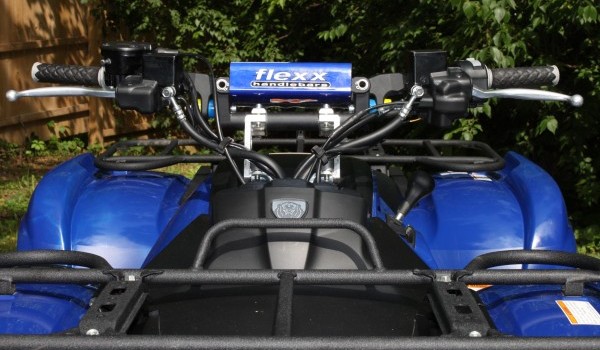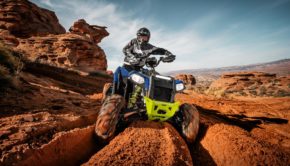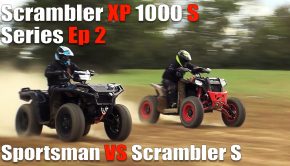Fasst Company Flexx Handlebars and Rox Speed FX Pivoting Handlebar Riser Test

Through the years, Flexx handlebars have been extremely popular with cross-country racers, and gained notoriety with a number of motocrossers.
Fasst Company’s Flexx Handlebar System has been around since late 2002. Through the years, these handlebars have been extremely popular with cross-country racers, and gained notoriety with a number of motocrossers. After using these bars on several ATVs–– most recently, our Suzuki Z400 project–– we feel that perhaps the best candidate for these bars are everyday, ATV enthusiasts, which leads us to our latest test of the Flexx handlebars–– this time, on a Yamaha Grizzly 700 4×4 with power steering.
The Grizzly has 7/8 inch handlebars which are tall and swept back. Our Enduro bend Flexx Bars are much lower with a straighter bend than stock and require 1 1/8 inch clamps. To accommodate our Flexx Bars, we utilized a set of patented Rox Speed FX’ Pivoting Handlebar Risers. The risers are available in 2-inch, 3-½ inch, and 5-inch rises and are available for any diameter bar and clamp combination for which you are trying to adapt.

In addition to setting the rotation of your bars, the Rox risers can pivot forward or rearward, allowing you to put your handlebars perfectly within reach.
In addition to setting the rotation of your bars, the Rox risers can pivot forward or rearward, allowing you to put your handlebars perfectly within reach. The clamps are constructed of 6061 T6 billet aluminum, and with no moving parts, they should outlast your ATV.
Rox recommended that we run their +5-inch risers, but assuming we knew better, we went with the +3.5-inch ones. If you order a set, tell Rox which machine and bars you are running and take their advice. The +5 – inch risers would have allowed us a bit more clearance over the tank and the ability to move the bars a bit closer, which would have worked out even better with our shorter, straighter Flexx Bars. We were able to obtain a comfortable position, but with no room to spare.
Flexx Bars come with four compression elastomers that feature different levels of stiffness from softest to hardest: blue, yellow, red, and black. A  couple generations back, Flexx Bars started coming with rebound elastomers, mounted on the opposite side of the thicker compression ones. The Rebound elastomers are designed to eliminate any top out sensation at the end of the bars’ rebound. Since most of the tuning is done through the compression elastomers, the Flexx Bars come with only red rebound elastomers, which are pre-installed. If you want to further tune your handlebars by switching out the rebound elastomers, Fasst Co. offers their Rebound kit , which includes yellow, red, and black elastomers, plus all the necessary hardware. The Rebound kit also installs on older model bars, like ours, allowing you to update bars for $23.99 instead of buying a complete new set.
couple generations back, Flexx Bars started coming with rebound elastomers, mounted on the opposite side of the thicker compression ones. The Rebound elastomers are designed to eliminate any top out sensation at the end of the bars’ rebound. Since most of the tuning is done through the compression elastomers, the Flexx Bars come with only red rebound elastomers, which are pre-installed. If you want to further tune your handlebars by switching out the rebound elastomers, Fasst Co. offers their Rebound kit , which includes yellow, red, and black elastomers, plus all the necessary hardware. The Rebound kit also installs on older model bars, like ours, allowing you to update bars for $23.99 instead of buying a complete new set.
We liked the resistance of the stock red elastomers on our Suzuki Z400 Project, but wanted to soften things up quite a bit for our Grizzly. We removed the red compression elastomers and installed the longer bolts from the Rebound Kit. The softest, blue, compression elastomers were installed and the softest, yellow, rebound elastomers were installed on the outside. We set the preload at three threads in, just enough to get rid of any play. Riders who want less upsweep, or a slightly firmer ride with less movement, can add more preload.
At this point, the only thing separating our updated Flexx bars from the latest generation is that older models need maintenance from time to time. Fasst Co. has rebuild kits for older models, or you can send them in for servicing. The latest version of the bars uses self -lubricating bushings in the pivot points, which according to Fasst Co., eliminates the need for rebuilds.
The Test
Equipping a stock utility machine with a set of Flexx Bars was a new experience for us. We are accustomed to using them on highly modified race quads, but their benefits were even more obvious on a stock ATV.
As plush as the Grizzly’s ride is, the bars made the ride even more comfortable. Although the Yamaha’s power steering works like a steering stabilizer, helping keep bump feedback from ripping the bars out of your hands, it doesn’t do anything for vertical impacts not fully absorbed by the suspension. Landing from jumps, or banging into and over logs, the bars absorbed impacts that weren’t fully absorbed by the shocks. The bars were especially helpful when hitting uneven bumps or when taking big hits at an angle.
The rebound elastomers eliminate the topping out sensation, making the overall movement feel a lot more fluid. They also provide a small amount of up stroke, which provides some cush when you jerk back on the bars to lighten the front end to clear an obstacle.
 Fasst Co. claims that the Flexx Bars reduce vibration. Honestly, we couldn’t tell a difference on the machines we have used them on. Perhaps, our test units didn’t emit enough vibration to detect the benefit. Suspension bar clamps may or may not offer better vibration damping, but they do not offer the amount on travel for vertical impacts as the Flexx Bars.
Fasst Co. claims that the Flexx Bars reduce vibration. Honestly, we couldn’t tell a difference on the machines we have used them on. Perhaps, our test units didn’t emit enough vibration to detect the benefit. Suspension bar clamps may or may not offer better vibration damping, but they do not offer the amount on travel for vertical impacts as the Flexx Bars.
With a reduction in maintenance, the latest generation Flexx Bars are an even better option than before, for riders looking to overcome the harshness of stock suspension, or racers looking for a way to save his wrists from the error of coming up short on a jump.
While many of our test riders like them, there are a few who don’t like the mild varying in geometry caused by bars movement. Some riders noted their additional weight, which is undetectable by almost anyone while riding. Overall, they work as advertised and are a great product for many riders. Whether you are a racer or a casual rider, if you’re looking to reduce fatigue, we would recommend you try a pair for yourselves.
Without the Rox Speed FX’ handlebar risers, this test couldn’t have taken place. They worked perfectly, and provided another level in ergonomic setup. For sport quad riders, they also cost a fraction of the price of an aftermarket steering stem. Best of all, Rox knows which size riser will best fit your needs.
Manufacturer: Fasst Coompany
Item: Flexx Handlebar System
Price: $349.99
Manufacturer: Rox Speed FX
Item: Rox Pivoting Bar Risers
Price: $89.95
Fasst Company Flexx Handlebars and Rox Speed FX Pivoting Handlebar Riser
Summary: they work as advertised and are a great product for many riders. Whether you are a racer or a casual rider, if you’re looking to reduce fatigue, we would recommend you try a pair of Flexx Bars for yourself.











